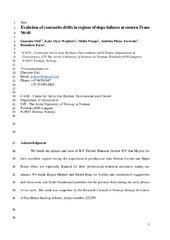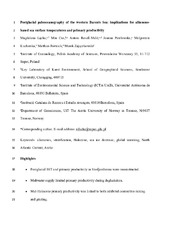Artikler, rapporter og annet (geovitenskap): Nye registreringer
Viser treff 501-520 av 825
-
Evolution of contourite drifts in regions of slope failures at eastern Fram Strait
(Journal article; Tidsskriftartikkel; Peer reviewed, 2019-11-15)Geotechnical characteristics of contouritic deposition often lead to preconditioning slope instabilities and failures along glaciated and formerly glaciated continental margins.<br> However, internal depositional geometry is also an important factor in triggering instabilities. This work highlights the importance of the tectonic and oceanographic evolution of the Northwestern (NW) Svalbard margin ... -
Physical controls of dynamics of methane venting from a shallow seep area west of Svalbard
(Journal article; Tidsskriftartikkel; Peer reviewed, 2019-12-06)We investigate methane seepage on the shallow shelf west of Svalbard during three consecutive years, using discrete sampling of the water column, echosounder-based gas flux estimates, water mass properties, and numerical dispersion modelling. The results reveal three distinct hydrographic conditions in spring and summer, showing that the methane content in the water column is controlled by a combination ... -
Benthic Foraminifera in Arctic Methane Hydrate Bearing Sediments
(Journal article; Tidsskriftartikkel; Peer reviewed, 2019-12-10)Benthic foraminifera have been widely used as proxy for paleo-methane emissions, mainly based on their stable isotopic signature. In cold seeps, the ecology of these organisms remains uncertain, in particular their ability to thrive during active phases of seepage. In this study, we evaluate the benthic foraminiferal response to methane seepage in Arctic sediments. We do so by examining living and ... -
Impact of drill cutting releases on benthic foraminifera at three exploration wells drilled between 1992 and 2012 in the SW Barents Sea, Norway
(Journal article; Tidsskriftartikkel; Peer reviewed, 2019-12-04)The aim of this study is to identify the environmental impact of drill cuttings (DC) released around three wells drilled in 1992, 2000 and 2012 in the SW Barents Sea. Foraminiferal assemblages are studied in cores taken along transects <250 m from wells. Well E-1992 shows no impact of DC on foraminifera indicating that low amounts of released DC limit environmental impact. Impact at wells G-2000 and ... -
Sylfjellet: a new outcrop of the Paleogene Van Mijenfjorden Group in Svalbard
(Journal article; Tidsskriftartikkel; Peer reviewed, 2019-12-05)A hitherto unrecognized Paleogene outcrop has been discovered at Sylfjellet, a mountain located at the northern side of Isfjorden, Svalbard. The strata, which cover an area of 0.8 km2, have until now been assigned to the Lower Cretaceous succession of the Adventdalen Group. In this study, the Sylfjellet site was studied in detail to provide an updated structural and sedimentological description of ... -
Postglacial paleoceanography of the western Barents Sea: Implications for alkenone-based sea surface temperatures and primary productivity
(Journal article; Tidsskriftartikkel; Peer reviewed, 2019-10-11)The increasing influence of Atlantic Water (AW) in the Barents Sea, a process known as “Atlantification”, is gradually decreasing sea ice cover in the region. Ongoing global climate warming is likely to be one of its drivers, but to further understand the role of natural variability and the biogeochemical impacts of the inflow of AW into the western Barents Sea, we reconstructed sea surface temperatures ... -
The marine sedimentary environments of Kongsfjorden, Svalbard: an archive of polar environmental change
(Journal article; Tidsskriftartikkel; Peer reviewed, 2019-09-16)Kongsfjorden, a fjord in north-western Svalbard, is characterized by large environmental gradients driven by meltwater processes along the margins of tidewater glaciers and the inflow of relatively warm Atlantic Water, the main heat source for the European Arctic. These factors make Kongsfjorden a key area to investigate changes in the polar climate–ocean–glacier system and to examine the resulting ... -
Baseline undersøkelse av studiekvalitet og undervisningskultur på Institutt for geovitenskap ved UiT Norges arktiske universitet
(Research report; Forskningsrapport, 2019-04)Institutt for geovitenskap ved UiT Norges arktiske universitet ønsker å gjøre en innsats for å forbedre undervisningen ved instituttet. Instituttet tilbyr utdanninger på bachelor-, master- og doktorgradsnivå, med 12 bachelorkurs, 28 masterkurs og 9 kurs på doktorgradsnivå. Dette prosjektet fokuserer på undervisningskvaliteten på bachelor- og master utdanningen. Vi håper rapporten kan bidra til ... -
Late Weichselian and Holocene palaeoceanography of Storfjordrenna, southern Svalbard
(Journal article; Tidsskriftartikkel; Peer reviewed, 2015-03-27)Multiproxy analyses (including benthic and planktonic foraminifera, δ<sup>18</sup>O and δ<sup>13</sup>C records, grain-size distribution, ice-rafted debris, XRF geochemistry and magnetic susceptibility) were performed on a <sup>14</sup>C-dated marine sediment core from Storfjordrenna, located off of southern Svalbard. The sediments in the core cover the termination of Bølling–Allerød, the Younger ... -
Exploring the teaching environment in a higher education geoscience programme
(Journal article; Tidsskriftartikkel; Peer reviewed, 2019-03-19)This paper explores the teaching environment among the teaching staff in thegeoscience programme at UiT The Arctic University of Norway. The findings in this paper are based on a large baseline study conducted in 2018. This paper operationalises the teaching culture by analysing the teachers’ ideas, collaborations, and attitudes towards teaching. In-depth interviews ... -
Image based quantitative comparisons indicate heightened megabenthos diversity and abundance at a site of weak hydrocarbon seepage in the southwestern Barents Sea
(Journal article; Tidsskriftartikkel; Peer reviewed, 2019-08-08)<p><i>Background - </i>High primary productivity in the midst of high toxicity defines hydrocarbon seeps; this feature usually results in significantly higher biomass, but in lower diversity communities at seeps rather than in the surrounding non-seep benthos. Qualitative estimates indicate that this dichotomy does not necessarily hold true in high latitude regions with respect to megafauna. Instead, ... -
Petroleum, coal and research drilling onshore Svalbard: a historical perspective
(Journal article; Tidsskriftartikkel; Peer reviewed, 2019-07-05)The beginning of the Norwegian oil industry is often attributed to the first exploration drilling in the North Sea in 1966, the first discovery in 1967 and the discovery of the supergiant Ekofisk field in 1969. However, petroleum exploration already started onshore Svalbard in 1960 with three mapping groups from Caltex and exploration efforts by the Dutch company Bataaffse (Shell) and the Norwegian ... -
Sedimentology and palynology of the Lower Cretaceous succession of central Spitsbergen: integration of subsurface and outcrop data
(Journal article; Tidsskriftartikkel; Peer reviewed, 2019-06-27)The Lower Cretaceous succession in Svalbard is commonly considered as an important analogue to age-equivalent strata on the Barents Shelf which are sporadically targeted by exploration wells. In this study, the stratigraphic and genetic relationship between the Rurikfjellet (open marine), Helvetiafjellet (paralic) and Carolinefjellet (open marine) formations of the Lower Cretaceous succession in ... -
Significance of substrate soil moisture content for rockfall hazard assessment
(Journal article; Tidsskriftartikkel; Peer reviewed, 2019-05-27)Rockfall modelling is an important tool for hazard analysis in steep terrain. Calibrating terrain parameters ensures that the model results more accurately represent the site-specific hazard. Parameterizing rockfall models is challenging because rockfall runout is highly sensitive to initial conditions, rock shape, size and material properties, terrain morphology, and terrain material properties. ... -
Conduit processes during the February 11, 2010 Vulcanian eruption of Soufriere Hills, Montserrat
(Journal article; Tidsskriftartikkel; Peer reviewed, 2019-01-29)We analyzed pumice from the February 11, 2010 Vulcanian explosion that immediately followed a large dome collapse at Soufrière Hills volcano. We obtained pre-explosive values of porosity, pressure, and depth by combining textural analyses and glass water content determinations. Our data suggest that the February 2010 explosion evacuated the upper 3 km of the conduit from the dense magma (≤10 vol% ... -
A High-Resolution Geomagnetic Relative Paleointensity Record From the Arctic Ocean Deep-Water Gateway Deposits During the Last 60 kyr
(Journal article; Tidsskriftartikkel; Peer reviewed, 2019-04-16)We present a paleomagnetic and rock magnetic data set from two long sediment cores collected from Bellsund and Isfjorden contourite drifts located on the eastern side of the Fram Strait (western Spitsbergen margin). The data set gave the opportunity to define the behavior of the past geomagnetic field at high latitude and to constrain the palaeoclimatic events that occurred in a time framework ... -
Cenozoic Erosion of the Barents Sea Shelf, Norwegian Arctic: A Review
(Conference object; Konferansebidrag, 2018-12)The circum North Atlantic-Arctic continental margin and adjacent land areas have experienced several episodes of uplift and erosion during the Cenozoic. A series of efforts quantifying this erosion for the Barents Sea shelf, where the Arctic shelf is at its widest and deepest have been done since the early 90’s using different methods. As the seismic and well database have expanded considerably, ... -
Chemosynthesis influences food web and community structure in high-Arctic benthos
(Journal article; Tidsskriftartikkel; Peer reviewed, 2019-10-25)Cold seeps are locations where seafloor communities are influenced by the seepage of methane and other reduced compounds from the seabed. We examined macro-infaunal benthos through community analysis and trophic structure using stable isotope analysis at 3 seep locations in the Barents Sea. These seeps were characterized by high densities of the chemosymbiotic polychaetes Siboglinidae, clade Frenulata ... -
Meter-Scale 3D Seismic Data for High-Resolution Site Characterization
(Conference object; Konferansebidrag, 2019-06-03)High-resolution 3D site characterization can deliver reliable quantitative property volumes of the subsurface when based on seismic data able to image meter-sized objects. Following the theoretical analysis of seismic wave propagation in the shallow sub-surface, we present case studies based on re-processing of 3D P-Cable seismic data. The case study of data re-processing from the Vestnesa Ridge ... -
Devonian core complex exhumation and Cenozoic decollements as alternatives to the Ellesmerian Orogeny
(Conference object; Konferansebidrag, 2018-10)The Ellesmerian Orogeny (Piepjohn et al., 2000) is a short-lived contractional–transpressional event that occurred in the Late Devonian–Mississippian, i.e., after Devonian collapse of the Caledonides and prior to Carboniferous rifting. Thus far, this episode of contraction–transpression was required to explain the presence of undeformed Carboniferous–Permian sedimentary rocks on top of folded ...


 English
English norsk
norsk


















